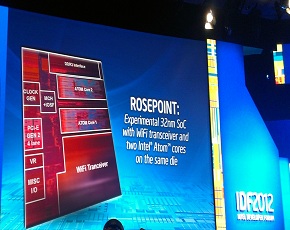Intel today announced it had achieved its goal of making fully digital radio chips to boost wireless capabilities in C.
Intel unveiled the technology during the Intel Developer Forum (IDF) held in San Francisco this week where, 10 years ago, Pat Gelsinger – the recently appointed CEO of VMware – put the company on the path towards a "radio free Intel", pledging to create the technology to get radio into all devices as standard and without extra charge.

"This was a dream… no, it was a fantasy, a fantasy comes become a dream is even realistic," said Justin Rattner, chief technology officer (CTO) at Intel.
"The mobile wireless group were particularly unhappy with his speech, they wanted to make radios and charge!"
The reason Gelsinger's vision was so unthinkable at the time was that radio technology had only worked as an analogue process. This means that while chips were continuing to get smaller thanks to the move to digital, radio could not scale at the same rate and was taking up more and more of the silicon as processor sizes diminished.
The breakthrough by Intel Labs now means radio transceivers – used so devices can access Wi-Fi, Bluetooth, 3G connections and so on – can use digital filtering and frequency synthesisers. This enables them to shrink substantially, compared to the analogue equivalent and fit onto the 32nm chips, (the size first used in Intel's core i3 and i5 processors released in 2010).
Intel has incorporated this breakthrough into a system-on-chip (SoC) codenamed Rosepoint, which features two Intel Atom core processors and a Wi-Fi transceiver on the same die.
"We went back to the books and it required some very creative mathematics," said Yorgos Palaskas, research leader for the radio integration lab at Intel.
"Now we will look to take this radio to productisation."
It is not clear when these chips will feature in hardware. With Intel planning to move to 14nm technology by the end of 2013, Palaskas and his team are going to have a lot of work to do to shrink the radio transceivers even further.
But, for now, Rattner is happy to say to his old colleague Gelsinger: "We have achieved our 10 year quest for radio free Intel, just with less of the free."





